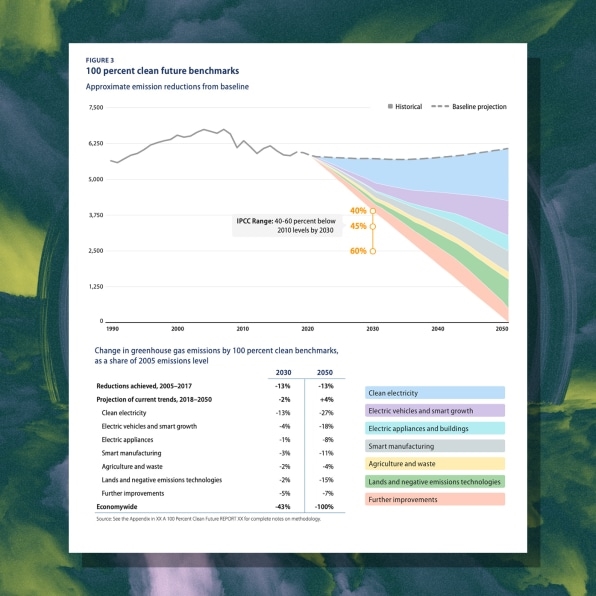It sounds daunting, but here’s how we can get to net-zero emissions by 2050
Last year, humans were responsible for emitting more than 40 billion metric tons of CO2 into the atmosphere. To avoid the worst impacts of climate change, scientists say that emissions need to shrink to net zero by 2050—just three decades from now.
That sounds daunting, but in a new report, researchers at the public policy research and advocacy organization Center for American Progress looked at how that massive transformation could take place in the U.S., drawing on plans from states that now aim to transition to zero emissions. The report looks at exactly what needs to happen in key sectors. “Not only do we need to have net-zero emissions by 2050, and not only do we have to have emissions reductions in 2030, but we also have to show how we’re getting from here to there,” says Trevor Higgins, one of the authors of the report.

The country needs to get to 65% renewable electricity by 2030 to be on track for 100% renewables in 2050, the report suggests. By 2035, every new car sold will need to be a zero-emission vehicle. Buildings and new appliances will need to be highly efficient and run on electricity by 2035. The manufacturing sector will have to cut emissions at least 15% by 2030 and set in place an agenda for deep decarbonization. By the same year, the country needs to invest billions in cutting emissions in agriculture and harnessing ways for farms to capture emissions. At least 30% of lands and oceans will need to be protected, and another 100 million acres of agricultural land will need to adopt “climate-smart” practices. Together, these key benchmarks could achieve 90% of the emissions reductions that are necessary.
It’s an overwhelming challenge—but achievable, say the researchers. To get political support, they say, it’s crucial to build broad coalitions and demonstrate some of the immediate benefits that will result. “This can’t just be about improving people’s lives in the future,” says Christy Goldfuss, one of the authors of the report. “There have to be results that people feel in the near term improve their lives. So, how are we delivering on high-quality, good-paying jobs? That’s something that addresses issues of unemployment and issues of transition right away. This is not just about emissions reduction in the future.” The report lays out the principles that the researchers think are necessary to make the transition successful and shows how to spur the same initiatives in other countries.
There’s momentum now to make it happen—depending in large part on the results of the next election—as presidential candidates put forth their own ambitious climate goals. “There really is an emerging consensus that we’re going to have to do as much as we can as quickly as possible across the economy, and all these different sectors, to reach our targets,” Goldfuss says.
(5)



